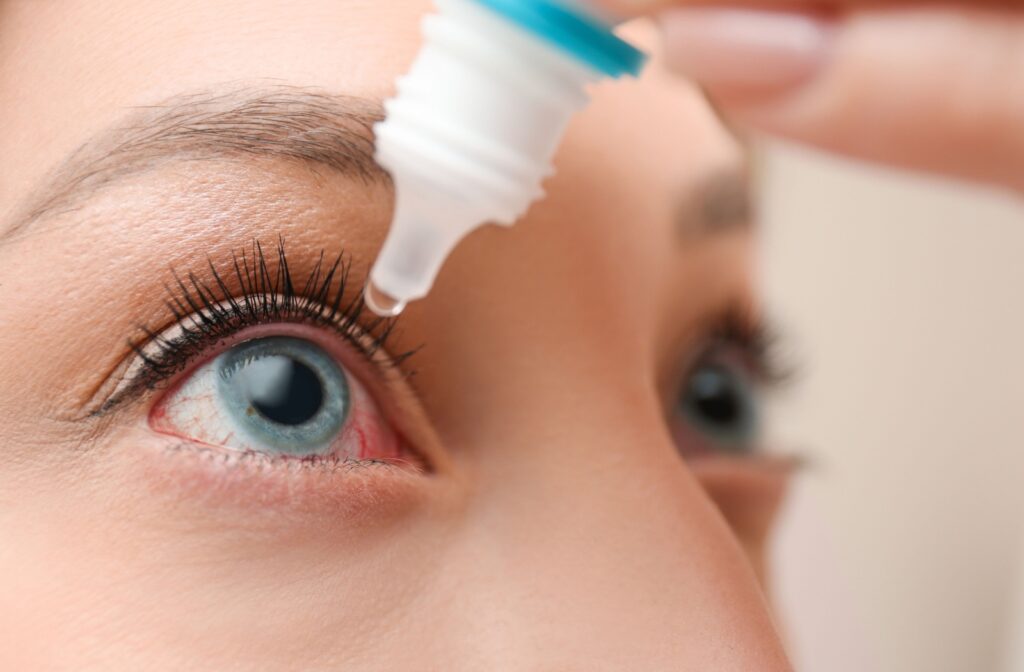If you start to notice irritation, inflammation, and redness in your eyes, you may be dealing with an eye infection. These symptoms aren’t something that you should ignore—an untreated eye infection can cause significant damage to your eyes if you don’t get help. So when you have an eye infection, what can you do? Can an optometrist treat an eye infection?
Remember—your optometrist is a trained eye care professional with a wealth of experience in eye-related conditions. They can examine the affected area of your eye, help design a personalized treatment plan for your infection , and help you find relief from your symptoms.
What Causes Eye Infections?
The body is incredibly intricate, with plenty of tiny structures and systems working together in harmony. However, it’s also extremely sensitive, and these systems are highly vulnerable to bacteria and viruses.
When you’re exposed to harmful particles and microorganisms, they can easily enter the eye and start wreaking havoc on these internal systems and structures. This becomes much more of a risk if you have poor eye hygiene or a weaker immune system.
Eye infections aren’t just an inconvenience. In some situations, these infections can cause permanent damage to your eyes, leading to lifelong problems with your vision. That’s why it’s so crucial to learn how to recognize eye infections; knowing what to look for lets you step in as soon as symptoms appear to address the situation.
How to Recognize Eye Infections
Eye infections can be complicated. The symptoms can vary depending on the specific cause of your infection and which part of the eye the infection is affecting. However, some general signs of infection include:
- Redness or a bloodshot appearance
- Swelling of the eyelids or surrounding areas
- Discharge from the eye
- Itching or burning sensations
- Increased sensitivity to light
- Blurred or decreased vision
If you experience any of these symptoms, talk to your optometrist. They can examine the affected area and diagnose your infection, then give you advice going forward to find relief.
So what are the different types of eye infections, and how can your optometrist treat them?
Conjunctivitis
Conjunctivitis, commonly called “pink eye,” is one of the most common eye infections. Conjunctivitis occurs when the conjunctiva—the thin membrane covering the whites of your eyes and the inside of the eyelid—becomes inflamed.
Conjunctivitis can develop due to:
- Bacteria
- Viruses
- Allergies
Typically, conjunctivitis/pink eye is recognizable by redness, discharge, watery eyes, and a constant itching sensation. These symptoms can vary depending on the specific type of conjunctivitis you’re experiencing, as can the treatment.
Your optometrist can help by diagnosing the specific type of pink eye that you’ve developed. Allergic pink eye can typically be managed through antihistamines and allergy medication, while bacterial conjunctivitis requires antibiotic eye drops or ointments to remove the infection. However, viral conjunctivitis is more difficult to treat, and symptoms usually recede on their own within a week or so. Your optometrist can give you personalized advice on managing symptoms.
Keratitis
Keratitis is an infection that inflames the cornea, the clear dome-shaped tissue at the front of your eye. Keratitis can develop due to bacteria, viruses, fungi, or even a physical injury.
This is a serious condition, since it affects the part of your eye that focuses light on the retina. It often causes:
- Redness
- Eye pain
- Blurry vision
- Light sensitivity
In some cases, keratitis can lead to scarring on your cornea, which can cause permanent vision loss. Fortunately, your optometrist can help; keratitis can often be treated with special eye drops that target the root cause of the infection.
Blepharitis
Blepharitis is an inflammation of the eyelids, typically affecting the area around their base. Blepharitis is caused by bacterial overgrowth, some skin conditions, or problems with the oil glands in your eyelids.
Blepharitis may also result from an over-population of microscopic mites living inside the eyelash follicles, known as Demodex mites.
While it typically doesn’t cause permanent damage, blepharitis can be a chronic, uncomfortable condition that can cause:
- Red, swollen eyelids
- Flaking or crusting around the eyelid margins
- Itching or burning sensation
- Eyelashes that appear greasy or clumped together
- Increased sensitivity to light
If you experience these symptoms, it’s important to consult with your optometrist for appropriate care and management. Blepharitis can be treated through in-office eyelid cleaning and at-home eye hygiene practices.
At Eye Lab, we offer ZEST (Zocular Eyelid System Treatment) in-office. This procedure is aimed at relieving dry eye symptoms by cleaning the eyelids and lashes. It uses a plant-based gel to gently exfoliate and remove debris, bacteria, and oils, improving eye comfort and reducing inflammation. This treatment enhances overall eye health and can provide lasting relief from dry eye discomfort.

Stye
A stye, also known as a hordeolum, is a painful, red bump that appears on or inside the eyelid. Styes develop due to a bacterial infection in the oil glands or hair follicles around the eyelids. While they generally aren’t serious, they can be quite uncomfortable.
You can recognize a stye by:
- Redness around the bump
- Swelling of the eyelid
- Tenderness or pain at the site
If you find yourself having recurring styes or bumps, it may be an indication that there is an underlying problem of dry eye syndrome. Your optometrist can help treat and manage your dry eye to help alleviate your eye discomfort.
A stye can easily be mistaken for a pimple. However, you should never pop a stye; this spreads bacteria and can lead to worsened eye infections. Instead, talk to your optometrist; they can guide you through treatment and, if needed, professionally drain the stye.
Uveitis
Uveitis is a term used to describe inflammation of the uvea, the middle layer of the eye. Uveitis can develop due to infections, autoimmune disorders, or even a recent injury around the eye. This is a serious condition that, if left untreated, can quickly lead to permanent vision loss.
Uveitis often causes:
- Eye redness
- Pain in or around the eye
- Decreased vision
- Sensitivity to light
- Floaters or spots in your vision
If you notice any of these symptoms, it’s crucial to talk to your optometrist as soon as you can. They’ll be able to coordinate your care going forward to help keep your vision clear. Whether they recommend eye drops, medication, cortical steroids, or another approach, your optometrist can help effectively manage this condition.
Don’t Risk Your Vision
If you’re dealing with any unusual symptoms, don’t leave them unaddressed. Instead, come see our team at Eye Lab. We can diagnose your specific condition and help you find relief from your infection. We’re committed to providing you with comprehensive care, so book an appointment with our team today.





